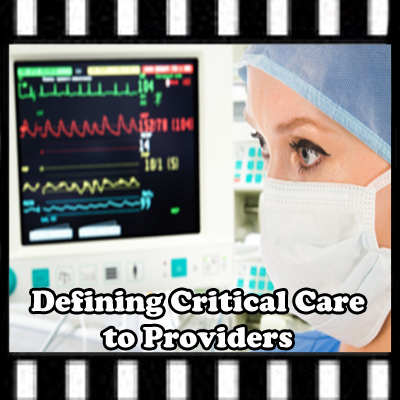Laureen: OK. Next question is on Critical Care. This must be a recent one because they said it was great seeing us at conference. That’s what I like the most, being in the booth and students coming up and thanking us. It really was a good ego boost, I have to say.
Alicia: [laughs] It was fun.
Laureen: I told the AAPC people, I don’t really get return on my investment, ROI, because it’s expensive to have a booth, but for my ego I get a lot of return on my investment.
Q: I need some assistance in clearly defining to a group of providers what “Critical Care” consists of. The CPT book, Medicare website and all other resources have pretty much the same information and cite the same examples. They are providing their care in the ICU and it appears that they may be thinking that all patients in the ICU are “critically ill.” Any thoughts? I’m having a presentation to their group next week and I’m expecting some push back from them.
Defining Critical Care to Providers – Medical Coding Tips — Video

A: OK. But you make a very good point, Kimberly, I agree with you; just because a patient is located in the ICU does not mean that their condition is critical. They could have been stabilized and are waiting for a bed and a step-down unit. So, what I tell my students when you think of E/M, think of it as being snobby, it’s status, status, status. So, we use the location to get us started, but we need to know their status to get to the right category and subcategory of E/M. So, just think of it as being very snobby.
Now, if you need to prove it to them, go right to the manual, right to the horse’s mouth, so to speak, and say this is from your American Medical Association, and this is how they define it. So, I kind of took key little sections and paragraphs and glued them together here. But basically the guidelines are telling us that it’s critical care delivery by a physician(s) or other qualified health care professional with a critically ill or critically injured patient. A critical illness or injury acutely impairs. And here’s the definition: one or more vital organ systems – yadiyadiya. It’s pages and pages of guidelines of what constitutes critically ill. But the key here is, it’s not where their room is, it’s what their condition is – that makes their status.
Down here, I highlighted here: Critical care is usually, but not always, given in a critical care area, such as the coronary care unit (the CCU), the intensive care unit, pediatric intensive care unit, respiratory care unit, or the emergency care facility. So, really, they could be critical anywhere. So, it’s about their status that they meet all the other guidelines about injury that acutely impairs one or more vital organ systems such that there’s a high probability of imminent or life threatening deterioration in the patient’s condition. So, that’s your proof right there. That’s what I would use.
Last but not least, snuck in the middle in there it says: Services for a patient who is not critically ill but happens to be in a critical care unit are reported using the other appropriate E&M codes. So, there it is right from the horse’s mouth.
By the way, all these little markings and underlining and highlighting, this is basically our claim to fame for teaching the courses that involves CPT, the CPC, the CPC-H, we teach this bubbling and highlighting technique. So, things stand out. For those who haven’t taken the board exam yet, so they stand out to you. Some notes are just fluff, they’re just cross references, so we do these techniques of bracketing, or circling information, and writing keynotes so it jumps out at you. And all of my notes in my book are available when you take either our CPC Blitz Review or our Physician-Based or Facility-Based Medical Coding Course. I’ve actually videotaped my CPT manual so that you can fast forward, rewind, pause, and copy every single note down, should you want to. So, that’s a really nice bonus there.
![[CCO] Certification Coaching Organization LLC [CCO] Certification Coaching Organization LLC](https://www.cco.us/wp-content/uploads/2015/05/CCO-Logo-2015-d3-500px.png)
